

A Rubric for Evaluating E-Learning Tools in Higher Education. The Rubric for E-Learning Tool Evaluation offers educators a framework, with criteria and levels of achievement, to assess the suitability of an e-learning tool for their learners' needs and for their own learning outcomes and classroom context. As educational developers supporting the incorporation of technology into teaching, we are often asked by instructors for a tailored recommendation of an e-learning tool to use in a particular course.
When they use the phrase e-learning tool, instructors are typically asking for some kind of digital technology, mediated through the use of an internet-connected device, that is designed to support student learning. Such requests tend to be accompanied by statements of frustration over the selection process they've undertaken. These frustrations often result from two factors. First, instructors are typically experts in their course's subject matter, yet they are not necessarily fluent in the best criteria for evaluating e-learning tools.
Scale. Reading Informational Texts Using the 3-2-1 Strategy. Home › Classroom Resources › Lesson Plans Lesson Plan Student Objectives Session 1 Session 2 Session 3.
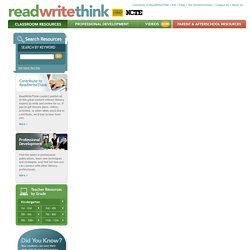
ExamSoft. CTS Tools for Faculty and Student Assessment. A number of critical thinking skills inventories and measures have been developed: Watson-Glaser Critical Thinking Appraisal (WGCTA) Cornell Critical Thinking Test California Critical Thinking Disposition Inventory (CCTDI) California Critical Thinking Skills Test (CCTST) Health Science Reasoning Test (HSRT) Professional Judgment Rating Form (PJRF) Teaching for Thinking Student Course Evaluation Form Holistic Critical Thinking Scoring Rubric Peer Evaluation of Group Presentation Form Excluding the Watson-Glaser Critical Thinking Appraisal and the Cornell Critical Thinking Test, Facione and Facione developed the critical thinking skills instruments listed above.
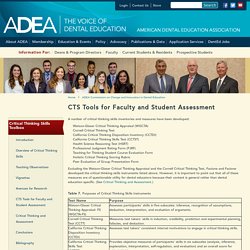
Course/Faculty Assessment (CFA): a Student Team Approach to Course and Faculty Assessment. Assessing critical thinking Archives. National Institute for Learning Outcomes Assessment. AAHE Principles of Good Practice: Aging Nicely - A Letter from Pat Hutchings, Peter Ewell, and Trudy Banta AAHE Principles of Good Practice: Aging Nicely Twenty years ago, in 1992, the American Association for Higher Education’s Assessment Forum released its “Principles of Good Practice for Assessing Student Learning,” a document developed by twelve prominent scholar-practitioners of the movement.
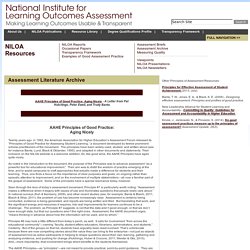
The principles have been widely used, studied, and written about (see for instance Banta, Lund, Black & Oblander, 1995), and adapted in other documents and statements. Their inclusion on the NILOA website is a welcome addition, for, like good wine, the AAHE Principles have aged quite nicely. As noted in the introduction to the document, the purpose of the Principles was to advance assessment “as a powerful tool for educational improvement.” Principle #6 may look a little different from today’s perch, as well. The principles are posted below this letter. December 1992 1. 2. 3. 4. 5. 6. 7. 8. 9.
Getting Started with Classroom Assessment Techniques. Classroom Assessment Techniques (CATs) Print Version What Are CATs?

Classroom Assessment Techniques (CATs) are generally simple, non-graded, anonymous, in-class activities designed to give you and your students useful feedback on the teaching-learning process as it is happening. Examples of CATs include the following. The Background Knowledge Probe is a short, simple questionnaire given to students at the start of a course, or before the introduction of a new unit, lesson or topic. It is designed to uncover students’ pre-conceptions.The Minute Paper tests how students are gaining knowledge, or not. Why Should I Use CATs? CATs can be used to improve the teaching and learning that occurs in a class. Classroom Assessment Techniques (CATs) The following guide is designed to explain and give examples of how in-class assessment can enhance university teaching and learning.
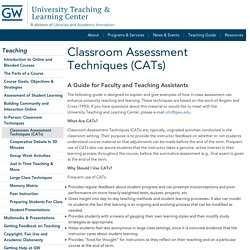
These techniques are based on the work of Angelo and Cross (1993). If you have questions about this material or would like to meet with the University Teaching and Learning Center, please e-mail utlc@gwu.edu. What Are CATs? Classroom Assessment Techniques (CATs) are, typically, ungraded activities conducted in the classroom setting. Their purpose is to provide the instructor feedback on whether or not students understand course material so that adjustments can be made before the end of the term.
Classroom Assessment Techniques (CATs) iPads Provide Dental Students with Fast, Formative Feedback on Clinical Performance - Teaching with Technology. Last week, a new piece of equipment was introduced for the Panoramic Imaging exercise DMD students were expected to complete in The Dental Center.
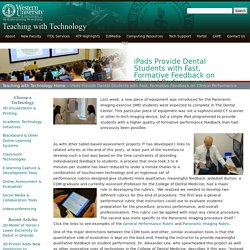
This particular piece of equipment was not a sophisticated CT scanner or other hi-tech imaging device, but a simple iPad programmed to provide students with a higher quality of formative performance feedback than had previously been possible. As with other tablet-based assessment projects IT has developed ( links to related articles at the end of this post), at least part of the incentive to develop such a tool was based on the time constraints of providing individualized feedback to students.
A process that once took 3 to 4 minutes per student has been reduced to under a minute thanks to a combination of touchscreen technology and an ingenious set of performance rubrics designed give students more qualitative, meaningful feedback. Role in developing the rubrics. While Drs. To learn more about this project, we encourage you to contact Dr. Writing Good Multiple Choice Test Questions. Multiple choice test questions, also known as items, can be an effective and efficient way to assess learning outcomes.
Multiple choice test items have several potential advantages: Versatility: Multiple choice test items can be written to assess various levels of learning outcomes, from basic recall to application, analysis, and evaluation. Because students are choosing from a set of potential answers, however, there are obvious limits on what can be tested with multiple choice items. Assessing Dental Students’ Competence: Best Practice Recommendations in the Performance Assessment Literature and Investigation of Current Practices in Predoctoral Dental Education. © 2008 American Dental Education Association + Author Affiliations Direct correspondence and requests for reprints to Dr.
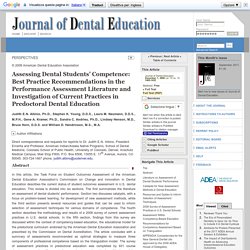
Judith E.N. Dental Student Assessment Toolbox. © 2009 American Dental Education Association + Author Affiliations Direct correspondence and requests for reprints to Dr.
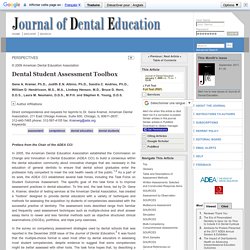
Gene Kramer, American Dental Association, 211 East Chicago Avenue, Suite 600, Chicago, IL 60611-2637; 312-440-7465 phone; 312-587-4105 fax; Kramerg@ada.org. Keywords: Preface from the Chair of the ADEA CCI: In 2005, the American Dental Education Association established the Commission on Change and Innovation in Dental Education (ADEA CCI) to build a consensus within the dental education community about innovative changes that are necessary in the education of general dentists to ensure that dental school graduates enter the profession fully competent to meet the oral health needs of the public.1,2 As a part of its work, the ADEA CCI established several task forces, including the Task Force on Student Outcomes Assessment.